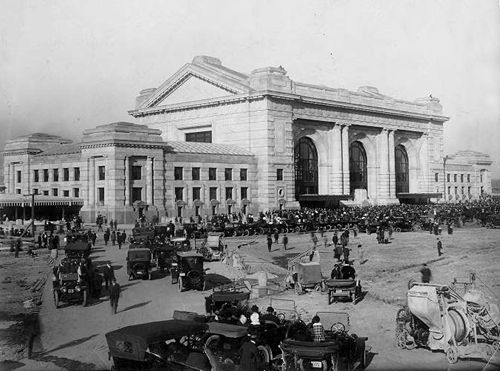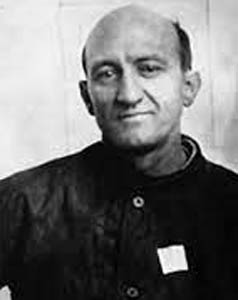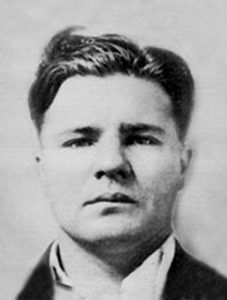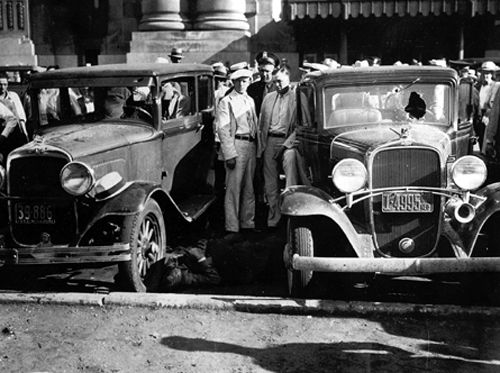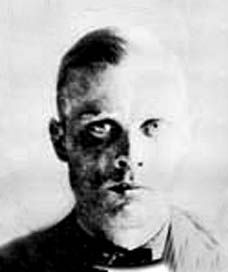The Kansas City Massacre was a shootout at the Union Station railroad depot in Kansas City, Missouri, on June 17, 1933.
This gun battle occurred when a gang led by Vernon Miller attempted to free Frank “Jelly” Nash, a federal prisoner. The Kansas City Massacre shocked the American public into a new consciousness of the serious crime problems in the Nation.
The killings, which took the lives of four peace officers and their prisoner, involved the attempt by Charles Arthur “Pretty Boy” Floyd, Vernon Miller, and Adam Richetti to free their friend, Frank Nash. At the time, Nash was in the custody of several law enforcement officers, returning him to the U.S. Penitentiary at Leavenworth, Kansas, where he escaped on October 19, 1930.
Nash’s criminal record reached back to 1913 when he was sentenced to life at the State Penitentiary in McAlester, Oklahoma, for murder. He was later pardoned. In 1920, he was given a 25-year sentence at the same penitentiary for burglary with explosives, and again, was later pardoned. On March 3, 1924, Nash began a 25-year sentence at the U.S. Penitentiary at Leavenworth, Kansas, for assaulting a mail custodian, but he escaped on October 19, 1930.
The Federal Bureau of Investigation (FBI) launched an intensive search for Nash, which extended over the entire United States and parts of Canada. Evidence gathered by the FBI indicated that Nash had assisted in the escape of seven prisoners from the U.S. Penitentiary at Leavenworth on December 11, 1931. The investigation also disclosed Nash’s close association with Francis L. Keating, Thomas Holden, and several well-known gunmen who had participated in bank robberies throughout the Midwest. Keating and Holden were apprehended by FBI Agents on July 7, 1932, in Kansas City, Missouri. The information gained by the FBI as a result of the apprehension of these two indicated that Nash was receiving protection from his underworld contacts in Hot Springs, Arkansas.
Based on this information, two FBI Agents, Frank Smith, and F. Joseph Lackey and McAlester, Oklahoma Police Chief Otto Reed, located and apprehended Nash on June 16, 1933, in a Hot Springs, Arkansas store. The law officers then drove Nash to Fort Smith, Arkansas, where at 8:30 that night, they boarded a Missouri Pacific train bound for Kansas City, Missouri. It was due to arrive there at 7:15 a.m. on June 17. Before leaving, the lawmen arranged for R.E. Vetterli, Special Agent in Charge of the FBI’s Kansas City Office, to meet them at the train station.
Meanwhile, several outlaw friends of Nash had heard of his capture in Hot Springs. They learned the time of the scheduled arrival of Nash and his captors in Kansas City and made plans to free him. Richard Tallman Galatas, Herbert Farmer, “Doc” Louis Stacci, and Frank B. Mulloy conceived and engineered the scheme. Vernon Miller was designated to free Nash, and while at Mulloy’s tavern in Kansas City, he made several phone calls for assistance in the scheme. At about this time, two gunmen, “Pretty Boy” Floyd and Adam Richetti, arrived in Kansas City and agreed to aid in the mission.
On their way to Kansas City, Floyd and Richetti had been detained at Bolivar, Missouri, early on the morning of the 16th, when their car broke down. While the two were waiting in a local garage for the necessary repairs, Sheriff Jack Killingsworth entered the building. Richetti, who immediately recognized the Sheriff, seized a machine gun and held the Sheriff and the garage attendants against the wall. Floyd drew two .45 caliber automatic pistols and ordered them to remain motionless. Floyd and Richetti then transferred their arsenal into another automobile and ordered the Sheriff in with them.
The two gangsters and their prisoner then drove to Deepwater, Missouri, abandoned that car, and abducted another. After releasing the Sheriff, they arrived in Kansas City at about 10:00 p.m. on June 16.
There, Floyd and Richetti abandoned the car and stole another before meeting up with Vernon Miller, who they went with him to his home. After arriving, Miller told them his plan to free Frank Nash, and Floyd and Richetti agreed to help. Early the following day, Miller, Floyd, and Richetti drove to the Union Railway Station, where they took up their positions to await the arrival of Nash and the authorities.
When the train arrived in Kansas City, Agent F. Joseph Lackey went to the loading platform, leaving Agent Frank Smith, Chief Otto Reed, and Nash in a stateroom. On the platform, he was met by Special Agent Vetterli, who FBI Agent R.J. Caffrey and Officers W.J. Grooms and Frank Hermanson of the Kansas City Police Department accompanied. These men surveyed the platform’s surrounding area and saw nothing that aroused their suspicion. Vetterli then advised Agent Lackey that he and Caffrey had brought two cars to Union Station and that the cars were parked immediately outside.
Agent Lackey then returned to the train and, accompanied by Chief Reed, Agents Vetterli, Caffrey, Smith, and Officers Hermanson and Grooms, proceeded from the train through the lobby of Union Station. At the time, Agent Lackey and Chief Reed were armed with shotguns, while the other officers carried pistols while escorting Frank Nash. Upon leaving Union Station, the lawmen, with their captive, paused briefly, and, again seeing nothing that aroused their suspicion, they proceeded to Caffrey’s car, which was parked directly in front of the east entrance of Union Station.
Agent Lackey noticed a green Plymouth parked about six feet away and two armed men approaching from behind the car as the agents and their captives began to climb into the cars. At least one of them had a machine gun.
Before Lackey could warn his fellow officers, one of the gunmen shouted, “Up, up!” as a third man with a machine gun began to approach. Special Agent in Charge Vetterli turned just in time to hear a voice command, “Let ’em have it!” At this point, from approximately 15 feet, an individual crouched behind the radiator of another car opened fire. Officers Grooms and Hermanson immediately fell to the ground dead. Vetterli, standing beside Office Grooms and Hermanson, was shot in the left arm and dropped to the ground. As Vetterli scrambled to take cover, Caffrey was fatally shot in the head. Already inside the car, Frank Nash and Chief Reed were killed by bullets from the gangster’s guns. Agents Lackey and Smith survived the massacre by falling forward in the back seat of their vehicle. Lackey was struck and seriously wounded by three bullets. Smith was unscathed.
The three gunmen rushed to the lawmen’s car and looked inside, one shouting, “They’re all dead. Let’s get out of here.” With that, they raced toward a dark-colored Chevrolet. Just then, a Kansas City policeman emerged from Union Station and began firing in the direction of the killers. One of them, later identified as Floyd, slumped briefly but continued to run. The gangsters scrambled into the car, sped westward out of the parking area, and disappeared.
The three survivors — Agents Smith, Lackey, and Vetterli reported that the assault lasted no more than 30 seconds. They were uncertain if three or four gunmen staged the assault. From their account, it was apparent that the two Kansas City Police Officers were killed immediately, followed seconds later by Frank Nash and Chief Reed and then by Agent Caffrey, who was taken to a hospital and pronounced dead on arrival.
The FBI immediately initiated an investigation to identify and apprehend the gunmen. The investigation developed evidence that the scheme was carried out by Vernon Miller, Adam C. Richetti, and Charles Arthur “Pretty Boy” Floyd. The evidence included latent fingerprint impressions located by FBI Agents on beer bottles in Miller’s Kansas City home, identified as those of Adam Richetti.
Following the Kansas City Massacre, Vernon Miller, accompanied by his girlfriend, Vivian Mathias, traveled to Chicago, arriving there about June 19, 1933. For a few days, he hid out with a member of the Barker-Karpis Gang. From there, he then reportedly went to New York. On October 31, 1933, an FBI investigation discovered he was back in Chicago with his girlfriend. The next day, he escaped a trap set for him by the FBI. However, Mathias was taken into custody and later pleaded guilty to harboring and concealing a fugitive.
Meanwhile, the FBI’s hunt for “Pretty Boy” Floyd and Adam Richetti continued. After fleeing the Kansas City Massacre, Floyd and Richetti made their way to Toledo, Ohio, where they met Beulah, also known as Juanita, and Rose Baird in early September 1933. From there, the four traveled to Buffalo, New York.
On September 21, 1933, Floyd and Beulah Baird, using the names of Mr. and Mrs. George Sanders, and Richetti and Rose Baird, using the names Mr. and Mrs. Ed Brennan, rented an apartment in Buffalo. The other occupants of the apartment building considered the two couples very mysterious, as they seldom left the apartment, only for brief visits to the grocery store. During that time, Floyd reportedly walked from the front to the rear of the apartment almost constantly, which caused much curiosity among the other building occupants. The two couples never visited with any of their neighbors, but the women occasionally threw money from the apartment windows to the children playing in the street or offered them candy.
In October 1934, the couples agreed to return to Oklahoma, and Rose Baird was given money to purchase a car to take them there. The four began the trip on October 20, with Floyd driving. A few hours later, near Wellsville, Ohio, he skidded the automobile into a telephone pole. Floyd and Richetti removed their firearms from the vehicle and remained on the outskirts of the town, while Rose and Beulah Baird took the damaged car into a Wellsville garage for repairs.
The Wellsville, Ohio, Police Chief, J.H. Fultz, following up on reports that two suspicious-looking men were seen on the outskirts of town, found the two resting in a wood tract of land nearby. A gun battle ensued. Chief Fultz apprehended Richetti after the gangster had emptied his gun at the officer. Floyd escaped, but the Police Chief thought Floyd might have been wounded.
Afterward, the FBI and local authorities conducted an intensive search for Floyd in eastern Ohio, which included interviews with numerous persons in the rural countryside, including doctors and hospital personnel whom Floyd might approach if he was wounded.
Eight of the participants in this search — a squad of four FBI Agents, along with a squad of four East Liverpool, Ohio police officers were jointly patrolling a group of roads south of Clarkson, Ohio, in two cars on October 22, when they noticed an automobile move from behind a corn crib on a farm. The officers had been questioning all persons they saw, and to question the automobile’s occupants, they stopped the car. At this point, the vehicle that had attracted their attention drove back to its original position behind the corn crib, and a man whom the officers immediately recognized as “Pretty Boy” Floyd jumped from the car with a .45 caliber automatic pistol in his right hand.
As the officers reached Floyd, he said, “I’m done for; you’ve hit me twice.” They took the pistol from his hand and seized a second gun he carried in his belt. The two FBI Agents then left to summon an ambulance to take Floyd to a hospital, but Floyd died about 15 minutes later.
When Floyd was killed, a watch and fob, consisting of a “lucky piece,” were found on his person. Groups of ten notches were found on each of these items – reportedly carved by Floyd to indicate the number of people he had killed.
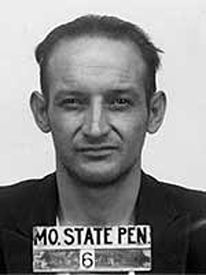
Adam Richetti, gangster
Rose and Beulah Baird, who were in the Wellsville garage attending to repairing the wrecked automobile when they overheard the discussion of Richetti’s being taken into custody, had left immediately for Kansas City, Missouri. Later, they traveled to the home of Floyd’s family in Sallisaw, Oklahoma, where they attended the funeral of Charles “Pretty Boy” Floyd.
Adam Richetti, following his apprehension, was returned to Kansas City, Missouri, and on March 1, 1935, was indicted on four counts of murder in the first degree. His trial, predicated on the indictment charging him with the murder of Frank E. Hermanson, one of the police officers killed in the Kansas City Massacre, began in Kansas City on June 10, 1935. On June 17, the jury returned a guilty verdict with the recommendation that Richetti be given the death penalty, and he was sentenced to be hanged. Though Richetti appealed his conviction because he was insane, the appeal was fruitless, and he was executed on October 7, 1938.
The four individuals – Richard Galatas, Herbert Farmer, “Doc” Louis Stacci, and Frank Mulloy – who were later found in the investigation to have aided in the conspiracy to free Nash, were indicted by a Federal Grand Jury at Kansas City, Missouri on October 24, 1934. On January 4, 1935, the four were found guilty of conspiracy to cause the escape of a Federal Prisoner from the custody of the United States. The following day, each was sentenced to serve two years in a Federal Penitentiary and pay a fine of $10,000, the maximum penalty allowed by law.
Primary Source: FBI History. Compiled and edited by Kathy Alexander/Legends of America, updated November 2023.
Also See:

